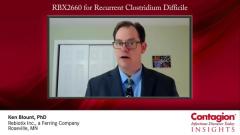
Clostridioides Difficile: Exciting Developments
Episodes in this series

Transcript:
Ken Blount, PhD: There’s a lot of exciting work going on. The C diff [Clostridioides difficile] field is very active right now. One of the things that we’re all waiting and watching for is another antibiotic in phase 3 clinical development called ridinilazole. It had a positive phase 2 trial. We’re all eager to see the phase 3 data.
More importantly, among Rebiotix Inc and parent company Ferring Pharmaceuticals and all the other companies running trials in this space, we’ve seen a real explosion of the knowledge around C diff as a pathogen, its pathogenesis, the disease, and how it affects patients. Our knowledge has increased exponentially over the last several years, and that’s really good for the patient, the health care system, and drug developers. We’re all learning more about how to manage this disease and how to improve it.
When we looked at that microbiome data for all of our trials, we were able to find a very clear pattern, which we call a Microbiome Health Index [MHI]. This is a single number based on the compositions of various bacteria, and we use it as a biomarker in our trials. What you see is that patients who come into the trial have been antibiotic treated, so they’re a good example of an antibiotic-induced dysbiosis, or antibiotic damage to the microbiome.
They have a very low MHI. After treatment, their MHI goes up much higher. Then we can actually derive a cutoff where we say, “OK, above this certain MHI level—the same way you would for other markers like blood pressure—is really indicative of a healthier microbiome. But if you get below that, you’re really starting to show some signs of antibiotic destruction or damage to your microbiome, which may trigger other considerations.”
We’ve started to take this outside of C diff and ask the question for other populations, can you start to gauge what level of damage a certain antibiotic did to the microbiome? We’re starting to apply the MHI to those types of questions, and we’re seeing that the MHI is quite effective at telling a difference between what are thought to be microbiome-sparing versus microbiome-damaging antibiotics. That’s a small example of how this explosion in all the translational biology and clinical research around C diff has developed knowledge that extends beyond C diff and pushes this forward as a community, both for the patients and the health care providers, as well as the drug developers.
We’re seeing a lot of trials approaching the late stage. For our phase 3, we notified the public that we do have a preliminary positive phase 3 readout. We’re expecting to see positive data next year that we will roll out at a major conference. We will also be starting a large trial with the capsule formulation that I just mentioned. There’s a lot of excitement. When we talk about that phase 3 for RBX2660, that’s pivotal because it represents potentially the first approval in this microbiota-based live biotherapeutic class. That opens the doors for a lot of additional approvals, a lot of additional investments, and potentially transformational approaches to health care.
Transcript Edited for Clarity
Newsletter
Stay ahead of emerging infectious disease threats with expert insights and breaking research. Subscribe now to get updates delivered straight to your inbox.




























































































































































































































































































